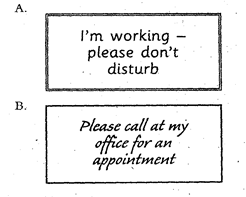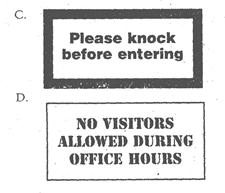
C
People do not analyze every problem they meet. Sometimes they try to remember a solution from the last time they had a similar problem. They often accept the opinions or ideas of other people. Other times they begin to act without thinking. They try to find a solution by trial and error. However, when all these methods fail, the person with a problem has to start analyzing. There are six stages in analyzing a problem.
First the person must recognize that there is a problem. For example, Sam’s bicycle is broken, and he cannot read it to class as he usually does. Sam must see that there is a problem with his bicycle.
Next the thinker must define the problem. Before Sam can repair his bicycle, he must find out the reason why it does not work. For instance, he must determine if the problem is with the gears, the brakes, or the frame. He must make his problem more specific.
Now the person must look for information that will make the problem clearer and lead to possible solutions. For instance, suppose Sam decided that his bike does not work because there is something wrong with the gear wheels. At this time, he can look in his bicycle repair book and read about gears. He can talk to his friends at the bike shop. He can look at his gears carefully.
After studying the problem, the person should have several suggestions for a possible solution. Take Sam as an illustration. His suggestions might be: put oil on the gear wheels; buy new gear wheels and replace the old ones; tighten or loosen the gear wheels.
Eventually one suggestion seems to be the solution to the problem. Sometimes the final idea comes very suddenly because the thinker suddenly sees something new or sees something in a new way. Sam, for example, suddenly sees that there is a piece of chewing gum between the gear wheels. He immediately realizes the solution to his problem: he must clean the gear wheels.
Finally the solution is tested. Sam cleans the gear wheels and finds that afterwards his bicycle works perfectly. In short , he has solved the problem.
51. What is the best title for this passage?
A. Six Stages for Repairing Sam’s Bicycle
B. Possible Ways to Problem-solving
C. Necessities of Problem Analysis
D. Suggestions for Analyzing a Problem
52. In analyzing a problem we should do all the following except .
A. recognize and define the problem
B. look for information to make the problem clearer
C. have suggestions for a possible solution
D. find a solution by trial or mistake
53. By referring to Sam’s broken bicycle, the author intends to _________.
A. illustrate the ways to repair his bicycle
B. discuss the problems of his bicycle
C. tell us how to solve a problem
D. show us how to analyze a problem
54. Which of the following is NOT true?
A. People do not analyze the problem they meet.
B. People often accept the opinions or ideas of other people.
C. People may learn from their past experience.
D. People can not solve some problems they meet.
55. As used in the last sentence, the phrase “in short” means _________.
A. in the long run B. in detail C. in a word D. in the end
科目:高中英語 來源:貴州省清華實驗學校09-10學年度高二下學期4月月考 題型:閱讀理解
C
People think being an artist must be a wonderful way to earn one's living. Of course, there are lots of great things about working for oneself, at home alone. What I really like is that nobody tells me what time to start in the morning, what to wear; or whether I can take the afternoon off and go to a football match.
But then, I have no one to chat with when I'm bored, no one to discuss last night's match with during the lunch-hour. Sure, I can spend the afternoon doing something I enjoy like swimming, walking the dog, or even sleeping, if I choose. But the work will still be there when I do finally get back home, and it's still got to be finished in time. Unfortunately, working at home means that people can always find me, whether I’m bored or not and once I’ve answered the doorbell, it's too late——my thoughts have been interrupted. No one would dream of calling if I worked in an office, but in an office I find myself making cups of coffee and listening to friends' troubles. As they talk, my ideas disappear and I feel increasingly stressed thinking of my work waiting to be done.
66. What is the writer trying to do in the text?
A. To encourage readers to work at home.
B. To explain why he has changed his job.
C. To describe his working life.
D. To say how he would like to work.
67. What can the reader learn from the text?
A. How to start working for oneself.
B. What it's like to work at home.
C. Why the writer decided to work for himself.
D. How artists become successful?
68. What does the writer like about his life?
A. He has plenty of opportunities for sport.
B. He is his own boss.
C. He can see people when he wants to.
D. He has a comfortable place to work.
69. What does the writer imagine he might do with colleagues ( 同事 ) ?
A. Have meals in restaurants.
B. Go to the swimming pool.
C. Spend time in the countryside.
D. Talk about sport.
70. Which of these notices would be most useful for the writer to put on his door?

查看答案和解析>>
湖北省互聯(lián)網(wǎng)違法和不良信息舉報平臺 | 網(wǎng)上有害信息舉報專區(qū) | 電信詐騙舉報專區(qū) | 涉歷史虛無主義有害信息舉報專區(qū) | 涉企侵權舉報專區(qū)
違法和不良信息舉報電話:027-86699610 舉報郵箱:58377363@163.com